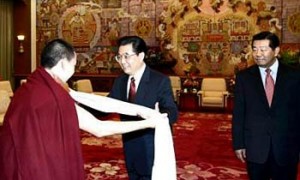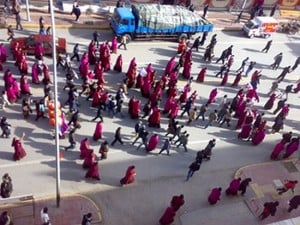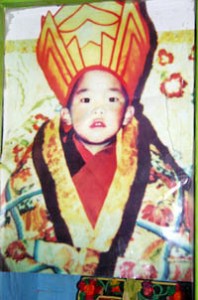- Security stepped up in Labrang and foreigners told to leave due to visit of Chinese-appointed Panchen Lama Gyaltsen Norbu in next few days
- Tibetans say they will not welcome him as they are loyal to Gendun Choekyi Nyima, recognised by the Dalai Lama as the Panchen Lama, and disappeared for last 16 years
- No historical precedent for a Panchen Lama to be based at Labrang Tashikhyil monastery; monks fear more repression and “patriotic education”
- Chinese strategy to force its Panchen Lama on Tibetans could backfire and lead to greater resistance: analysis

Gyaltsen Norbu, known to many Tibetans as Gya Panchen (Chinese Panchen) is received at the Great Hall of the People by China’s President and Party Secretary, Hu Jintao, on the eve of Gyaltsen Norbu’s 15th birthday in 2005. Hu Jintao appropriates the Tibetan tradition of the presentation of a khatag (white scarf).
The disappearance of the Panchen Lama, acknowledged as one of Tibet’s most important religious leaders, and the installation of an alternative candidate by Beijing, has come to symbolize for Tibetans the struggle for survival of their religious culture.
Gyaltsen (Chinese: Gyalcain) Norbu is due to visit one of the most important centers of Tibetan religious culture in Tibet, Labrang Tashikhyil monastery, in Sangchu county in the Kanlho (in Chinese, Gannan) Tibetan Autonomous Prefecture in Gansu province, possibly by the end of this week. According to one source, the presence of troops outside Labrang Tashikhyil monastery has visibly increased over the past few days, with several sources indicating that hundreds of armed police are now stationed around the monastery.
Gyaltsen Norbu, described by many Tibetans as the ‘Gya Panchen’ (‘Gya’ comes from the Tibetan word for Chinese, ‘Gyami’), was originally due to visit Labrang Tashikhyil in the last week of July, according to several Tibetan sources. His visit was postponed even though the local government warned it would cut the salaries or fire officials who objected to the visit.
According to Tibetans from Labrang who are now in exile, monks have been told that the Chinese Panchen Lama will stay for at least a few months. The Democratic Management Committee of the monastery has ordered monks to perform a cham (ritual monastic) dance for the visit and to prepare a new part of the monastery called the Norzin Potrang (palace) as his accommodation. Numerous surveillance cameras have been set up around the palace, which is currently where the head of Labrang Tashikhyil monastery, Jamyang Jabpa, resides. Jamyang Jabpa is a respected religious figure who is also the Deputy Director of the National People’s Congress in Gansu Province (an official biography of Jamyang Jabpa is published here).
Tibetans are overwhelmingly loyal to Gendun Choekyi Nyima, the young man recognised by the Dalai Lama as the 11th Panchen Lama. International organizations including the U.N. Committee on the Rights of the Child who have sought to ascertain details of Gendun Choekyi Nyima’s welfare and education have been denied access to him by the Chinese government. Tibetan writer and blogger Woeser, who is based in Beijing, was quoted by the New York Times this week as saying: “We just hope he is still alive. We are waiting for him.” The Panchen Lama, a title that means Great Scholar, should serve as an important spiritual teacher and has historically had a special relationship with the Dalai Lama who is also a Gelugpa monk.
Labrang Tashikhyil monks ordered to prepare the monastery

Protests near Labrang Monastery on March 14, 2008. (TCHRD)
Some Tibetans in contact with exile sources say that it may even be the beginning of a period in which Gyaltsen Norbu is based in Gannan Tibetan Autonomous Prefecture in Gansu Province, as opposed to Beijing where he currently lives. This would signal the Chinese authorities’ move to enforce his presence on Tibetans as part of their strategy of control and potentially to develop his political role and influence. The Chinese authorities have already made Gyaltsen Norbu Vice-President of the state-run Buddhist association and appointed him to the Chinese People’s Political Consultative Conference, an advisory body that meets in Beijing. He has said that Buddhism’s responsibility is “to foster patriotism and national unity.”
There is no religious precedent for installing a Panchen Lama at Labrang Tashikhyil; the Panchen Lama’s seat is Tashilhunpo Monastery in the Tibet Autonomous Region, and his second seat is Kumbum Monastery in Qinghai province. The decision may be linked to the relationship of the head of Labrang Tashikhyil, Jamyang Jabpa, with the Chinese authorities in Beijing. Gyaltsen Norbu’s tutor Jamyang Gyatso is also from Labrang Tashikhyil. The objective of bringing Gyaltsen Norbu to Labrang Tashikhyil may be an attempt by the authorities to further undermine Tibetan Buddhist culture in the eastern Tibetan area of Amdo, where Tibetan identity is strong and where scholars and monks have been on the frontline of asserting their religious and national identity, particularly since 2008, and most notably recently in Ngaba (Chinese: Aba) (ICT report, New developments at Kirti Monastery; crackdown shows no sign of easing).
The imposition of Gyaltsen Norbu as the Panchen Lama is also an important element of the authorities’ aim to undermine the influence of the Dalai Lama and local Tibetan lamas and senior monks. It represents an attempt by Beijing to give the impression to the outside world that Tibetan Buddhist traditions are being protected.
Tibetans from the area, including former Labrang Tashikhyil monks, believe that ultimately it is a strategy that could backfire. One Tibetan scholar from Amdo, now in exile and who asked not to be named, said: “It’s true that some traditional religious teachings could have filtered through, as one of his teachers is an important scholar, but ultimately Gyaltsen Norbu is not accepted as legitimate by Tibetans. The fact that he is being imposed upon the Tibetans in an area where Tibetan identity and culture are very strong could create more discontent and problems and may even reinforce Tibetans’ resolve to oppose Chinese policies.”
The same Tibetan source said: “The Chinese Panchen Lama obviously has state patronage, so a lot of money is involved in his visit or long stay in Tibet. Just as we have seen before in different ways, it is likely there will be ‘rewards’ for monasteries or institutions that are classified by the authorities as ‘patriotic’, and it could lead to further impoverishment and alienation for institutions and individuals who are perceived to be loyal to the Dalai Lama. I’m sure there will be an increase in patriotic education and repressive measures.”
In the late 1990s, the Chinese authorities attempted to bring Gyaltsen Norbu to Kumbum Monastery, which led to the abbot Arjia Rinpoche seeking asylum in the United States in 1998.

An image of the 11th Panchen Lama, Gedun Choekyi Nyima, seen in a monastery in eastern Tibet near a photograph of the Dalai Lama. It is relatively rare to see an image of Gedun Choekyi Nyima, who was taken into custody at the age of six, in Tibet. This picture is unusual because it portrays him in ceremonial religious robes, which have been superimposed onto the only known image of him as a child to have been made public.
Why the Panchen Lama is important
Historically, the Panchen Lama has been one of Tibet’s most highly revered religious figures, with a unique relationship to the Dalai Lama; he is known as the ‘moon’ and the Dalai Lama as the ‘sun’. On occasion, Panchen Lamas have played a role in the recognition and subsequent education of the Dalai Lamas, and vice versa, which is why control over the institution of the Panchen Lama is considered to be crucial by Beijing. But the Dalai Lama has clearly placed on record on numerous occasions that if the present situation regarding Tibet remains the same, he will be reincarnated outside Tibet away from the control of the Chinese authorities.
The focus on controlling tulkus (reincarnate lamas) through measures introduced in 2007 by the Chinese government also takes into account the political difficulties faced by the authorities following their failure to secure the allegiance of some senior reincarnate lamas in Tibet in recent years. For instance, the 17th Karmapa, who was being groomed by the Chinese government as a ‘patriotic’ figurehead, escaped from Tibet in 1999 and is now living in exile in India close to the Dalai Lama. Arjia Rinpoche, then the abbot of Kumbum monastery in Qinghai, who also held several official positions, defected to the US in 1998. Both made statements afterwards about the lack of genuine religious freedom in Tibet (ICT report, The Communist Party as Living Buddha: The crisis facing Tibetan religion under Chinese control)
Tibetans refuse to welcome Chinese Panchen to Labrang Tashikhyil
The Chinese Panchen Lama has visited Labrang Tashikhyil monastery before, and Radio Free Asia reported a Tibetan woman living near Labrang saying last week that: “The Chinese authorities [have been] telling the local Tibetans that they have to come out to welcome the Panchen Lama when he arrives. A few years ago, the Chinese government brought the Panchen Lama to Labrang Tashikhyil, but the local people refused to attend. This year, too, many Tibetans are saying that they won’t come out to show respect.”
Labrang Tashikhil is one of the largest monasteries in Tibet, and is adjacent to Sangchu county town. As the principal Tibetan cultural center in the region, it has also been a focus of symbolic nationalist protest and cultural activity in recent years, mostly led by local monks and nuns.
On March 14, 2008, the same day that the Lhasa protests turned violent, Labrang Tashikhyil monks led a crowd that grew into thousands of local people on a pro-independence demonstration in Sangchu county during the afternoon and evening. It was the first major signal that the protests were to spread right across Tibet, apparently taking the PRC authorities by surprise. The authorities began their current crackdown by dispersing the demonstrators with tear gas, and during the evening of March 14, armed police raided Labrang Tashikhyil monastery, smashing altars, burning images of the Dalai Lama and threatening the monks. (ICT report, Tibet at a Turning Point). Two Labrang Tashikhyil monks died, one following severe torture, from a group of 15 monks who protested in front of foreign journalists at Labrang Tashikhyil monastery on April 9, 2008. (ICT report, Torture blamed for death of Tibetan monk, second death following protest during foreign reporters’ visit to Labrang monastery) A Labrang Tashikhyil monk known as Labrang Jigme became the first Tibetan to document his own torture and imprisonment in a video posted on Youtube in which he revealed his own identity (ICT report, Labrang Jigme, monk who gave torture testimony, returns home).
Insights into Gyaltsen Norbu
Many Tibetans are tolerant in their views towards Gyaltsen Norbu as a person, taking the view that he also has no choice about his situation. A Tibetan monk interviewed by ICT several years ago who was at Tashilhunpo monastery in Shigatse (Chinese: Xigaze) gave a rare insight into the Chinese-appointed Panchen Lama as follows: “Before, all the monks would call him ‘Yangsi’ [meaning ‘reincarnation’] but then that was banned and we were told that the monks are not allowed to call him ‘Yangsi’. Then it was said that the monks have to call him ‘Panchen Lama’s Yangsi’ instead. So now some monks call him Olo [baby]. But some monks still call him Yangsi even though this way of referring to him has been banned.”
The monk continued:
“Gyaltsen Norbu gives audiences to monks but we only go out of duty. Normally they are only attended by government officials and Party cadres. There has been a change recently though. Earlierwhen Gyaltsen Norbu gave speeches or public talks it seemed as though he was told to say this and that rather than speak his own words. But recently, perhaps because he has grown up, if he gives a lecture or speech he seems to use his own words, and I think he is seriously interested in religion because he strongly advises us to be good monks. Of course, he always says certain things like we have to listen to the government and we shouldn’t do anything political, but that is because he himself is under a lot of pressure from the government. I have heard that Gyaltsen Norbu is a smart boy who recognizes his Tibetan identity and responsibility. He has to study all different subjects ranging from traditional religious studies to modern subjects like science and mathematics. He doesn’t seem to have any time to rest as his schedule is fully packed. Gyaltsen seems to show loyalty and concern for Tibet. The authorities boast about his intelligence and scholarship considering his young age and say that he should rise in official positions, so it is fitting that monks at Tashilhunpo respect and hold him in high regard.
“Every shrine in the monastery must put up a picture of the Gya Panchen. Pictures were also distributed to individual monks who were ordered to put the picture on their altar. But I haven’t seen his picture on anyone’s altar.
“Even in the smallest and most remote villages people ask you where is the real Panchen Rinpoche. There is an overwhelming interest in the status of the real Panchen Rinpoche and his well-being. We talk only among our trusted friends about the plight of Tashilhunpo and the precarious future of Panchen Rinpoche. Except for a few Chinese loyalists, every monk wishes for his safe return. Most believe that he is alive as the Chinese understand the importance of keeping him well and alive.
“There are monks who keep pictures of His Holiness and the real Panchen Rinpoche’s picture behind other pictures — they are all waiting for a day when they can freely put them up where they are supposed to be. Everybody in the monastery knows the date of his birthday very well and many proffer special prayers that day in secret.”

